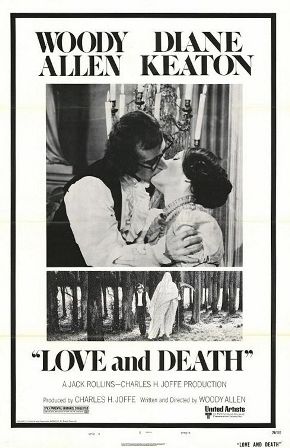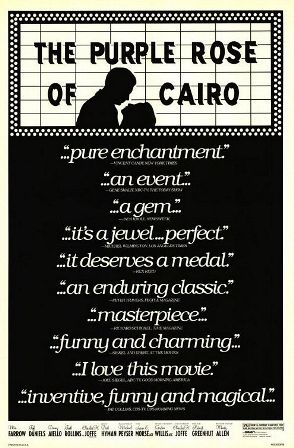CHICAGO – Patrick McDonald of HollywoodChicago.com appears on “The Morning Mess” with Dan Baker on WBGR-FM (Monroe, Wisconsin) on March 21st, 2024, reviewing the new streaming series “Manhunt” – based on the bestseller by James L. Swanson – currently streaming on Apple TV+.
Film Feature: The Top 10 Underrated Woody Allen Films
5. “Manhattan Murder Mystery” (1993)

Manhattan Murder Mystery
Perhaps no film in Allen’s career is as accessible as “Manhattan Murder Mystery.” Even my sister (who is far from an Allen fanatic) can’t help getting swept up in the giddy suspense endured by a Manhattan couple as they stumble upon a mystery. This is one of the rare mystery movies where the amateur detectives truly appear to be winging it. Carlo Di Palma’s handheld cinematography brings a sense of spontaneity, tension and palpable danger to each scene, thus inspiring an abundance of uneasy laughter, and a great jolting moment set in the claustrophobic confines of an elevator. The probable killer next door (Jerry Adler) is the sort of Raymond Burr-type who seems far too normal to be on the level. So when his wife suddenly dies, he becomes the prime suspect in the eyes of neighbor Carol (Diane Keaton), much to the chagrin of her husband, Larry (Allen). Inspired by the discarded murder subplot from “Annie Hall,” this comedy proves that Keaton and Allen hadn’t lost an ounce of their uproariously funny, warmhearted chemistry. Keaton’s daffiness is a perfect match for Allen’s mounting incredulity, and their relationship causes the arbitrary plot to be placed on the back-burner. Filling his reliable role as “the other man” in an Allen love triangle, Alan Alda has a wonderful moment in a parked car, as he keeps a lookout for a shady character. When he sees her, he shouts her name while crouching behind the dashboard. The hilarity of this scene is emblematic of the film’s appeal—it allows audiences to share in the thrill of getting away with something.
QA: “There’s nothing wrong with you that can’t be cured with a little Prozac and a polo mallet.”
4. “Sweet and Lowdown” (1999)

Sweet and Lowdown
This is one of the most original films of Allen’s career, and also one of his unsung achievements, despite its two Oscar nominations. First-time viewers could easily be fooled into believing that the main character, Emmet Ray (Sean Penn), was a real jazz guitarist in the ’30s. Allen has a series of knowledgeable talking heads interject factoids about Ray’s life, a conceit that further strengthens the illusion that Ray was a real man. He might as well have been. At first sight, Ray is about as far removed from an Allen protagonist as one could imagine, but on closer inspection, one can detect shades of Marion Post. He’s a self-deluded savant who feels glimmers of affection for a young mute lass, Hattie (Samantha Morton), before retreating beneath his carefree façade. Only after the pang of loss causes his repressed emotions to bubble toward the surface does Ray obtain the ability to perform the best music of his career—and what beautiful music he makes. This is the only Allen film that inspired me to purchase its soundtrack, and it has since then become one of my favorite albums. The performance sequences are flat-out thrilling, with Penn masterfully mimicking the fingerings of Howard Alden’s awe-inspiring guitar solos. One is reminded of De Niro’s bullheaded antiheroes in Scorsese pictures while watching Penn charge blindly through his life, unaware of the signals that could prove to be his salvation. Morton’s portrayal is worthy of the great screen sirens, as she projects the humorous innocence and nagging sadness of Chaplin. Though the film is a drama at heart, it does include one of Allen’s funniest set-pieces, requiring Penn to be gracelessly lowered onto the stage while hanging from a plywood moon during a performance. It’s a great bit of physical comedy that culminates in an explosive instance of impeccable comic timing.
QA: “You got heft. Makes a guy feel like he’s been someplace.”
3. “Interiors” (1978)

Interiors
When it arrived in theaters, “Interiors” was the first Allen film to deeply polarize his fans. Some rejected it simply because it wasn’t a comedy. Others dismissed it as a pretentious imitation of the Ingmar Bergman films that Allen held in such high esteem. Yet there were a handful of people (mainly critics) who were blown away by the director’s assured command of tone, which was more evocative of Eugene O’Neill’s operatic family dramas. I consider myself a member of the third group, though the film’s Bergmanesque compositions, gorgeously lensed by Gordon Willis (“The Godfather”), shouldn’t be ignored. This is not the cold, cerebral film that its detractors have suggested. Its emotions are all the more lacerating because they are kept burrowed beneath a seemingly tranquil surface. Eve (Geraldine Page), the overbearing interior designer and matriarch whose breakdown coupled with electric shock therapy has led to her downward spiral, is the forbearer of Marion Post and Emmet Ray. Her obsessive need for a carefully calculated environment has proven to have detrimental effects on her grown children. Joey (Mary Beth Hurt) is bursting with feelings, but can’t find a way to express herself. Flyn (Kristin Griffith) has beautiful features but lives a vapid life devoid of substance. Renata (Diane Keaton) is a successful writer, but her success proves to be of little consolation. Her growing preoccupation with her own mortality has caused the outside world to appear threatening. After Eve’s husband (E.G. Marshall) asks her for a trial separation, Allen externalizes her subdued agony by interrupting the silence with the cacophonous noise of strapping tape as its applied to Eve’s doors and windows prior to her latest suicide attempt. Maureen Stapleton is vivacious as a vulgarian who provides a splash of red on the family’s canvas awash in sterile beiges. The climax is a tour de force of symbolism so exquisite and provocative that it does, in fact, warrant comparison with Bergman and O’Neill. “Interiors” is a knock-out.
QA: “I can’t seem to shake the real implication of dying. It’s terrifying. The intimacy of it embarrasses me.”
2. “Love and Death” (1975)

Love and Death
Perhaps it’s no coincidence that the films Allen made before and after his timeless 1977 classic, “Annie Hall,” were among the best of his career. Whereas “Interiors” signified the director’s more serious filmmaking aspirations, “Love and Death” sounded the death knell for what fans would wistfully refer to as the “earlier, funnier” Allen. This farce, set in czarist Russia, parodies the exact same Bergmanesque camera angles that Allen would earnestly utilize a mere few years later—in a way, “Love and Death” and “Interiors” offer the ultimate “Melinda and Melinda” experience. Yet even if viewers are unfamiliar with Bergman, as well as the literature of Russian novelists such as Tolstoy and Dostoyevsky, they will have no trouble enjoying the rapid-fire gags and briskly paced hilarity of this oft-forgotten gem. Every bit as tirelessly inventive as Allen’s 1973 hit, “Sleeper,” this film further proves that Diane Keaton was far and away the best screen partner Allen ever had. Their laughably incoherent philosophical debates include some of the biggest laughs of any Allen pictures. When Keaton coos about a man who warmed the cockles of her heart, Allen jealousy whines, “Nothing like hot cockles!” When Keaton backs up an argument by utilizing words of wisdom uttered by Attila the Hun, Allen exclaims, “You’re quoting a Hun to me?!” It’s clear that the Bill Murray of “Ghostbusters” was somehow influenced by the Allen of “Love and Death,” who was himself influenced by Bob Hope and Groucho Marx. He views the godless universe filled with phony prophets and wrongly accused men from a detached perspective that enables him to laugh in its face. His ensemble, consisting entirely of straightmen, causes him to appear like the smartest and most nervous guy in the room. As Russia becomes engulfed in the chaos of the Napoleonic War, Allen is always standing on the sidelines, excusing himself with the claim that he’s due back on planet Earth.
QA: “The key here is to not think of death as an end, but as a very effective way of cutting down on your expenses.”
1. “The Purple Rose of Cairo” (1985)

The Purple Rose of Cairo
Allen’s 14th feature is, quite simply, as great a picture as any in his filmography, and one of the most profound films ever made about the power of cinema. For battered Depression-era waitress Cecilia (Mia Farrow), cinema has a cleansing power, but it comes with a price. For a few fleeting hours, she’s able to lose herself entirely within the frivolous concerns of the wealthy and beautiful, before being spat back out onto the pavement. The turbulence of her reality has caused her to hunger for the comfort of illusion. It’s the same comfort that people of faith find at church, a communal venue not unlike a movie theater. After Cecilia attends several viewings of the same film, a handsome, good-natured character named Tom Baxter (Jeff Daniels), becomes so taken with his ardent fan that he steps off the screen and into her life. And so begins an existential comedy on par with Pirandello’s landmark play, “Six Characters in Search of an Author.” Tom provides Cecilia with all the joy and fulfillment that she never received from her loutish, abusive husband (Danny Aiello). His sole downfall is that he’s not real. There’s an unforgettable moment when Tom hands out fake dollar bills to men standing in line at a soup kitchen, providing them with a sense of superficial hope. Cinema specializes in giving us hopes and dreams, none of which are tangible, yet hope in itself is more tangible than lies. The hope that Tom represents is more real than the artificiality of Gil Shepherd (Daniels), the actor who’s skilled in manipulating people in order to preserve his career. Shepherd shares in the public’s bewilderment that his character has somehow gained a life of its own. Tom’s abandoned co-stars are left on the screen to reflect on the absurdity of their existence, while panicky studio executives desperately attempt to secure the fate of their potential crowd-pleaser. I’m sure Allen’s studio executives could relate when they watched the director’s final cut, and predicted that it would be a box office smash…as long as the director agreed to shoot a happier ending. Allen, of course, stuck to his guns, and released the film with its gloriously poetic yet distressingly downbeat final moments intact, resulting in great reviews and little public fanfare. A quarter century later, Allen made a strikingly similar film about a man who chooses reality over his dream world, and ends up flourishing. The film went on to become the most lucrative picture of Allen’s career. Go figure.
QA: “I’m in love with a wonderful new man. He’s fictional, but you can’t have everything.”
 | By MATT FAGERHOLM |



Nice list, Matt. I would add
Nice list, Matt.
I would add Stardust Memories, what a great film!
My own favorite underrated WA film
Alice (1990) is my absolute favorite Woody Allen film and it seems to be quite underrated and/or unknown. The screenplay is wonderful and Mia Farrow gives one of her very best performances. For anyone who loves The Purple Rose of Cairo or Midnight in Paris, Alice would prove to be a similarly delightful romantic fantasy.